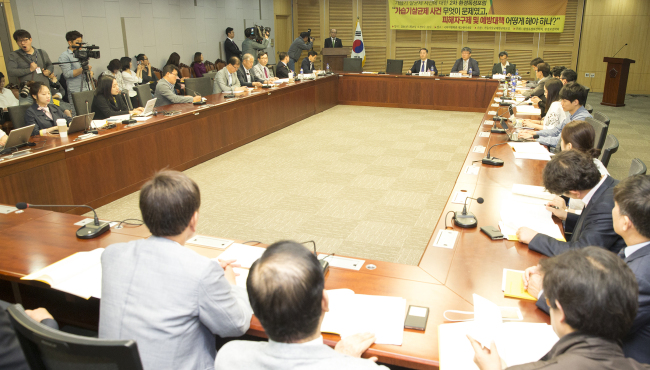About 30 percent of the Korean population has likely been exposed to the toxic humidifier disinfectant, an expert claimed Wednesday.
According to a survey conducted last year by Asan Medical Center’s medical professor Hong Soo-jong, 31.3 percent of children aged 7 were found to have used the humidifier disinfectant at home. About 1,500 children were surveyed.
 |
Participants attend a forum on ecotoxic substances at the National Assembly on Wednesday. (Yonhap) |
“If their families are included, about 30 percent of the total Korean population is speculated to have used the disinfectant,” said Hong at the second forum on ecotoxic substances held by the Korean Society of Environmental Health and Toxicology and Korean Society of Environmental Health.
Hong claimed that the disinfectant may have affected organs other than the lungs.
“According to the toxicity experiment of PHMG and PGH, fish which were exposed to those chemicals died within 70 minutes, which indicates that they affect other organs. Rhinitis, diabetes, arteriosclerosis or fatty liver should also be considered,” said Hong.
Occupational medicine professor Paek Do-Myung of Seoul National University suggested that about 11 million of the population might have been exposed to the disinfectant -- about 22 percent of the population -- considering the three rounds of a health probe conducted by the Korea Centers for Disease Control and Prevention in its epidemiologic survey. Paek was cochair of the probe team.
“Although the significant association between the product toxicity and lung damage has already been revealed, more concrete facts should be uncovered. The government and civic groups should draw up support measures that embraces the victims,” said Paek.
Meanwhile, another former CEO of Oxy Reckitt Benckiser is likely to be summoned later this month, investigators said.
The Seoul Central District Prosecutors’ Office said it would soon question former Korean-American CEO John Lee who had headed Oxy -- currently RB Korea -- from June 2005 to May 2010. This period was when sales of toxic humidifier disinfectant had soared. The 48-year-old has been serving as the chief of Google Korea since 2014.
The prosecution will look into whether he had known of the product’s toxicity and whether he had responsibility in decisions to skip the safety test. It will also question him about whether there was direction or involvement from the U.K. headquarters over the sales.
Lee is the second former CEO to be summoned. Former Oxy CEO Shin Hyun-woo was arrested Saturday for accidental homicide charges along with two other officials including Oxy’s senior researcher surnamed Choi.
In the latest revelation of evidence, prosecutors said Choi had been warned of chemical toxicity in 2000 by the head of a household chemical product manufacturer surnamed Noh whose firm had developed the humidifier disinfectant for the first time in 1994.
When the two met in 2000, Noh reportedly said that an independent safety test must be conducted as the inhalation-toxicity of PHMG had not been proven anywhere in the world. Noh had substantial experience in the field, having acquired more than 10 patents in the use of disinfectant substances.
When the prosecution raided Oxy’s office and research center in February, it found a note that Choi had written about Noh’s warning.
The humidifier disinfectant was introduced in the market in October 2000 without the inhalation-toxicity test.
By Lee Hyun-jeong (
rene@heraldcorp.com)








![[Today’s K-pop] Blackpink’s Jennie, Lisa invited to Coachella as solo acts](http://res.heraldm.com/phpwas/restmb_idxmake.php?idx=644&simg=/content/image/2024/11/21/20241121050099_0.jpg)